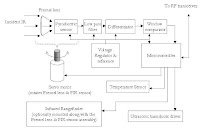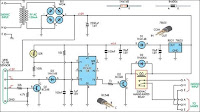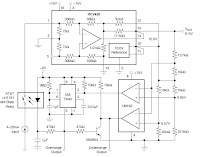Sunday, April 19, 2009
Descrete Multistage Light Sequencer Circuit
The drawing below illustrates a multistage light sequencer using
descrete parts and no integrated circuits. The idea is not new
and I hear a similar circuit was developed about 40 years ago
using germanium transistors. The idea is to connect the lights so
that as one turns off it causes the next to turn on, and so forth.
This is accomplished with a large capacitor between each stage
that charges when a stage turns off and supplies base current to
the next transistor, thus turning it on. Any number of stages can
be used and the drawing below illustrates 3 small Christmas lights
running at about 5 volts and 200mA. The circuit may need to be
manually started when power is applied. To start it, connect a
momentary short across any one of the capacitors and then
remove the short. You could use a manual push button to do this.
The circuit below uses a hex Schmitt Trigger inverter (74HC14)

60 Light Sequencer Circuit using a Matrix
The circuit below illustrates using a 10x10 matrix to sequence up
The LED circuit is drawn showing 25 LEDs and 10 transistors but

more
LED sequencer
The model 4017 integrated circuit is a CMOS counter with ten
Labels: led
Descrete Multistage Light Sequencer Circuit
The drawing below illustrates a multistage light sequencer using
descrete parts and no integrated circuits. The idea is not new
and I hear a similar circuit was developed about 40 years ago
using germanium transistors. The idea is to connect the lights so
that as one turns off it causes the next to turn on, and so forth.
This is accomplished with a large capacitor between each stage
that charges when a stage turns off and supplies base current to
the next transistor, thus turning it on. Any number of stages can
be used and the drawing below illustrates 3 small Christmas lights
running at about 5 volts and 200mA. The circuit may need to be
manually started when power is applied. To start it, connect a
momentary short across any one of the capacitors and then
remove the short. You could use a manual push button to do this.
The circuit below uses a hex Schmitt Trigger inverter (74HC14)

60 Light Sequencer Circuit using a Matrix
The circuit below illustrates using a 10x10 matrix to sequence up
The LED circuit is drawn showing 25 LEDs and 10 transistors but

more
LED sequencer
The model 4017 integrated circuit is a CMOS counter with ten
Labels: led
Saturday, April 18, 2009
Transistor LED flasher Circuit
This circuit has a lot going for it. For one thing, it only consists of two
transistors, two capacitors and four resistors. That also means it
consumes very little power. You can control the flash rate by changing
the size of the 100k resistors (100k makes for a pretty slow rate).
You can also control the duty cycle by using resistors of different
values on the two sides. The 470 ohm resistors control the current
through the LEDs. Normally you want to limit this to 20mA, but to
conserve battery power, you may need to limit it even further. You
can also connect several LEDs in series, instead of using only one
for each side. With red LEDs (1 per side) and the values shown,
the circuit draws about 11mA. more
more
Basic LED flasher circuit using NE555 timer IC
This circuit consumes more power, but it's advantage is when
 more
more4 Parallel LEDs flashing circuit
Nominal flash rate: 1.3 Hz. Average IDRAIN e 2 mA

General Description
The LM3909 is a monolithic oscillator specifically designed
to flash Light Emitting Diodes. By using the timing capacitor
for voltage boost, it delivers pulses of 2 or more volts to the
LED while operating on a supply of 1.5V or less. The circuit
is inherently self-starting, and requires addition of only a battery
and capacitor to function as an LED flasher.
Packaged in an 8-lead plastic mini-DIP, the LM3909 will operate
over the extended consumer temperature range of
b25§C to a70§C. It has been optimized for low power drain
and operation from weak batteries so that continuous operation
life exceeds that expected from battery rating.
Application is made simple by inclusion of internal timing
resistors and an internal LED current limit resistor. As
shown in the first two application circuits, the timing resistors
supplied are optimized for nominal flashing rates and
minimum power drain at 1.5V and 3V.
12 LED Flasher
LED flasher in this circuit use 12 LED it can show 2 style .

more
1.5 volt dual LED flasher Circuit
This 1.5 volt led fasher runs more than a year on a single 'd" cell
Labels: led
Transistor LED flasher Circuit
This circuit has a lot going for it. For one thing, it only consists of two
transistors, two capacitors and four resistors. That also means it
consumes very little power. You can control the flash rate by changing
the size of the 100k resistors (100k makes for a pretty slow rate).
You can also control the duty cycle by using resistors of different
values on the two sides. The 470 ohm resistors control the current
through the LEDs. Normally you want to limit this to 20mA, but to
conserve battery power, you may need to limit it even further. You
can also connect several LEDs in series, instead of using only one
for each side. With red LEDs (1 per side) and the values shown,
the circuit draws about 11mA. more
more
Basic LED flasher circuit using NE555 timer IC
This circuit consumes more power, but it's advantage is when
 more
more4 Parallel LEDs flashing circuit
Nominal flash rate: 1.3 Hz. Average IDRAIN e 2 mA

General Description
The LM3909 is a monolithic oscillator specifically designed
to flash Light Emitting Diodes. By using the timing capacitor
for voltage boost, it delivers pulses of 2 or more volts to the
LED while operating on a supply of 1.5V or less. The circuit
is inherently self-starting, and requires addition of only a battery
and capacitor to function as an LED flasher.
Packaged in an 8-lead plastic mini-DIP, the LM3909 will operate
over the extended consumer temperature range of
b25§C to a70§C. It has been optimized for low power drain
and operation from weak batteries so that continuous operation
life exceeds that expected from battery rating.
Application is made simple by inclusion of internal timing
resistors and an internal LED current limit resistor. As
shown in the first two application circuits, the timing resistors
supplied are optimized for nominal flashing rates and
minimum power drain at 1.5V and 3V.
12 LED Flasher
LED flasher in this circuit use 12 LED it can show 2 style .

more
1.5 volt dual LED flasher Circuit
This 1.5 volt led fasher runs more than a year on a single 'd" cell
Labels: led
Thursday, April 16, 2009
A simple automatic motion-detection Digital Camera Circuit
When the sensor detects movement in a room it will take a burst of
10 photos with the digital camera. Each photo is taken at 0.5sec
interval. After the 10 photos, the camera waits 3 seconds for further
movement and if it is detected, the process is repeated until 80
photos are taken.
The photos can then be downloaded to your PC (via the USB
connection on the board) for viewing.
The Directional Infrared Detector Module Circuit (DIRM)
Figure shows a block diagram of the DIRM. A Fresnel lens
captures the incident IR and focuses it towards the
pyroelectric sensor increasing the sensitivity of the sensor
and improving its directional response. The resultant signal
passes through a low pass filter, which removes any high
frequency noise generated by mechanical vibration. The
output of the filter is then fed into a differentiator, which
produces an output voltage proportional to the rate of
change of the incident IR. The frequency response of this
differentiator is also rolled off at high frequencies, further
reducing the effects of undesired signals. The window
comparator produces a logic output whenever the rate of
change of incident IR exceeds a given set point.
An 8-bit PIC16F84 microcontroller processes the logic
signals and controls the rotating platform and reports
information to the team leader.

more
PIR DETECTOR USING ST7FLITE05 MICROCONTROLLER
A PIR detector can be made easily with ST7FLITE05 using the
circuit shown in Figure. The sensor interfacing circuit (shown on
the left side of the microcontroller in Figure ) can be divided
into the following modules:
1.Transistor circuit used as an amplifier.
2.Transistor biasing controlled through the microcontroller.
3. Software-controlled transistor output.

more pdf
Infrared, Alarm, and PIC Microcontroller
OBJECTIVES:
• Get familiar with an infrared emitter diode and receiver.
• Create an obstacle detector with an infrared emitter and receiver.
• Learn about PIC microcontroller and programming a PIC microcontroller.
• Write a PIC program and build the circuit of a household alarm system.

more pdf
Ultra-low Power Motion Detection using the MSP430F2013
A system capable of detecting motion using a dual element PIR
sensor is shown in Figure 1 using the MSP430F2013
microcontroller. Using the integrated 16-bit Sigma-Delta
analog-todigital converter and built-in front-end PGA (SD16_A),
the MSP430F2013 provides all the required elements for interfacing
to the PIR sensor in a small footprint. With integrated analog
and a 16MHz, 16-bit RISC CPU, the MSP430F2013 offer a great
deal of processing performance in a small package and at a low cost.
Labels: Infrared, Microcontroller, sensor
A simple automatic motion-detection Digital Camera Circuit
When the sensor detects movement in a room it will take a burst of
10 photos with the digital camera. Each photo is taken at 0.5sec
interval. After the 10 photos, the camera waits 3 seconds for further
movement and if it is detected, the process is repeated until 80
photos are taken.
The photos can then be downloaded to your PC (via the USB
connection on the board) for viewing.
The Directional Infrared Detector Module Circuit (DIRM)
Figure shows a block diagram of the DIRM. A Fresnel lens
captures the incident IR and focuses it towards the
pyroelectric sensor increasing the sensitivity of the sensor
and improving its directional response. The resultant signal
passes through a low pass filter, which removes any high
frequency noise generated by mechanical vibration. The
output of the filter is then fed into a differentiator, which
produces an output voltage proportional to the rate of
change of the incident IR. The frequency response of this
differentiator is also rolled off at high frequencies, further
reducing the effects of undesired signals. The window
comparator produces a logic output whenever the rate of
change of incident IR exceeds a given set point.
An 8-bit PIC16F84 microcontroller processes the logic
signals and controls the rotating platform and reports
information to the team leader.

more
PIR DETECTOR USING ST7FLITE05 MICROCONTROLLER
A PIR detector can be made easily with ST7FLITE05 using the
circuit shown in Figure. The sensor interfacing circuit (shown on
the left side of the microcontroller in Figure ) can be divided
into the following modules:
1.Transistor circuit used as an amplifier.
2.Transistor biasing controlled through the microcontroller.
3. Software-controlled transistor output.

more pdf
Infrared, Alarm, and PIC Microcontroller
OBJECTIVES:
• Get familiar with an infrared emitter diode and receiver.
• Create an obstacle detector with an infrared emitter and receiver.
• Learn about PIC microcontroller and programming a PIC microcontroller.
• Write a PIC program and build the circuit of a household alarm system.

more pdf
Ultra-low Power Motion Detection using the MSP430F2013
A system capable of detecting motion using a dual element PIR
sensor is shown in Figure 1 using the MSP430F2013
microcontroller. Using the integrated 16-bit Sigma-Delta
analog-todigital converter and built-in front-end PGA (SD16_A),
the MSP430F2013 provides all the required elements for interfacing
to the PIR sensor in a small footprint. With integrated analog
and a 16MHz, 16-bit RISC CPU, the MSP430F2013 offer a great
deal of processing performance in a small package and at a low cost.
Labels: Infrared, Microcontroller, sensor
Wednesday, April 15, 2009
Infrared motion detector Circuit
The pyroelectric sensor is made of a crystalline material that
generates a surface electric charge when exposed to heat in the
form of infrared radiation. When the amount of radiation striking
the crystal changes, the amount of charge also changes and
can then be measured with a sensitive FET device built into the
sensor. The sensor elements are sensitive to radiation over a wide
range so a filter window is added to the TO5 package to limit
detectable radiation to the 8 to 14mm range which is most sensitive
to human body radiation.
Typically, the FET source terminal pin 2 connects through a
pulldown resistor of about 100 K to ground and feeds into a two
stage amplifier having signal conditioning circuits. The amplifier
is typically bandwidth limited to below 10Hz to reject high
frequency noise and is followed by a window comparator that
responds to both the positive and negative transitions of the
sensor output signal. A well filtered power source of from 3 to
15 volts should be connected to the FET drain terminal pin 1
MX063 PIR SENSOR LIGHT Circuit

more
Application Schematic of Pyroelectric Infrared Motion
Sensors Circuit
Note: For best results the power supply should be very stable
at a constant +5V DC +/- .2V.This Schematic is offered for reference only without warranty
of any kind. Microsystem Technologies does not support user
designs or implementations that use this circuit

more
Automatic security lights Circuit
Combination PIR sensor and floodlight units are cheap but
rather inflexible if you want to locate the sensor and light in
different places. In my case, I wanted to detect movement
on the driveway and switch on the lights in the carport around
the corner. Yet another job for the ubiquitous PICAXE-08
microcontroller

The sensor interfaces to the PICAXE (IC1) on input 2 (pin 5).
This pin is pulled low via isolation diode D3 and the normally
open (NO) output of the sensor whenever movement is
detected. It can also be pulled low by transistor Q1, which acts
as a simple inverter for sensors with normally closed (NC) outputs.
more
Passive Infrared Motion Detector Circuit
This circuit was originally reverse -engineered from a motion
detecting yard light that I ripped apart. That's still probably the
best way to get the parts at a reasonable price, especially the
pyroelectric sensor and the absolutely necessary Fresnel lens.
The signal at pin 7 of the 324 is very interesting and fooling with
the filtering around the first amplification stage can make it even
more so. The LM324 is a wonderful little bug, and you will find
many uses for the window comparator if you look at it the same
way you would learn a new really useful knot. It all works on a
single 5 volt supply. The sensor is only sensitive to changes
across its surface, so don't expect a signal from a static object
even if it is hot. Yard lights are turning up at flea markets and yard
sales as people find themselves heads up every time the cat walks
past. This circuit is in a machine that sees people moving 40 feet
away.
Infrared motion detector Circuit
The pyroelectric sensor is made of a crystalline material that
generates a surface electric charge when exposed to heat in the
form of infrared radiation. When the amount of radiation striking
the crystal changes, the amount of charge also changes and
can then be measured with a sensitive FET device built into the
sensor. The sensor elements are sensitive to radiation over a wide
range so a filter window is added to the TO5 package to limit
detectable radiation to the 8 to 14mm range which is most sensitive
to human body radiation.
Typically, the FET source terminal pin 2 connects through a
pulldown resistor of about 100 K to ground and feeds into a two
stage amplifier having signal conditioning circuits. The amplifier
is typically bandwidth limited to below 10Hz to reject high
frequency noise and is followed by a window comparator that
responds to both the positive and negative transitions of the
sensor output signal. A well filtered power source of from 3 to
15 volts should be connected to the FET drain terminal pin 1
MX063 PIR SENSOR LIGHT Circuit

more
Application Schematic of Pyroelectric Infrared Motion
Sensors Circuit
Note: For best results the power supply should be very stable
at a constant +5V DC +/- .2V.This Schematic is offered for reference only without warranty
of any kind. Microsystem Technologies does not support user
designs or implementations that use this circuit

more
Automatic security lights Circuit
Combination PIR sensor and floodlight units are cheap but
rather inflexible if you want to locate the sensor and light in
different places. In my case, I wanted to detect movement
on the driveway and switch on the lights in the carport around
the corner. Yet another job for the ubiquitous PICAXE-08
microcontroller

The sensor interfaces to the PICAXE (IC1) on input 2 (pin 5).
This pin is pulled low via isolation diode D3 and the normally
open (NO) output of the sensor whenever movement is
detected. It can also be pulled low by transistor Q1, which acts
as a simple inverter for sensors with normally closed (NC) outputs.
more
Passive Infrared Motion Detector Circuit
This circuit was originally reverse -engineered from a motion
detecting yard light that I ripped apart. That's still probably the
best way to get the parts at a reasonable price, especially the
pyroelectric sensor and the absolutely necessary Fresnel lens.
The signal at pin 7 of the 324 is very interesting and fooling with
the filtering around the first amplification stage can make it even
more so. The LM324 is a wonderful little bug, and you will find
many uses for the window comparator if you look at it the same
way you would learn a new really useful knot. It all works on a
single 5 volt supply. The sensor is only sensitive to changes
across its surface, so don't expect a signal from a static object
even if it is hot. Yard lights are turning up at flea markets and yard
sales as people find themselves heads up every time the cat walks
past. This circuit is in a machine that sees people moving 40 feet
away.
Thursday, April 9, 2009
4-20mA Current Loop Receiver with Input Overload
Protection circuit
to convert a 4–20mA input signal into a 0–5V
output signal. As a monolithic circuit, it offers high
reliability at low cost. The circuit consists of a premium
grade operational amplifier, an on-chip precision
resistor network, and a precision 10V reference. The
RCV420 features 0.1% overall conversion accuracy,
86dB CMR, and ±40V common-mode input range.
FEATURES
-COMPLETE 4-20mA TO 0-5V CONVERSION
- INTERNAL SENSE RESISTORS
-PRECISION 10V REFERENCE
- BUILT-IN LEVEL-SHIFTING
- ±40V COMMON-MODE INPUT RANGE
- 0.1% OVERALL CONVERSION ACCURACY
- HIGH NOISE IMMUNITY: 86dB CMR
A current-sensing circuit derives its power from the

digital-signal recovery circuit

power supply of a 4-20mA loop. Also included is circuitry for recovering
a digital signal superimposed on that loop. U1 (a high-side current-
sense amplifier with comparator and reference) senses the loop current
in R1 as an 8-40mV voltage and amplifies it by 100, producing an
output-voltage range of 0.8V to 4V. That output (VOUT) can directly
drive external meters, strip-chart recorders, and A/D converter inputs.
More pdf
4-20mA Current Loop Receiver with Input Overload
Protection circuit
to convert a 4–20mA input signal into a 0–5V
output signal. As a monolithic circuit, it offers high
reliability at low cost. The circuit consists of a premium
grade operational amplifier, an on-chip precision
resistor network, and a precision 10V reference. The
RCV420 features 0.1% overall conversion accuracy,
86dB CMR, and ±40V common-mode input range.
FEATURES
-COMPLETE 4-20mA TO 0-5V CONVERSION
- INTERNAL SENSE RESISTORS
-PRECISION 10V REFERENCE
- BUILT-IN LEVEL-SHIFTING
- ±40V COMMON-MODE INPUT RANGE
- 0.1% OVERALL CONVERSION ACCURACY
- HIGH NOISE IMMUNITY: 86dB CMR
A current-sensing circuit derives its power from the

digital-signal recovery circuit

power supply of a 4-20mA loop. Also included is circuitry for recovering
a digital signal superimposed on that loop. U1 (a high-side current-
sense amplifier with comparator and reference) senses the loop current
in R1 as an 8-40mV voltage and amplifies it by 100, producing an
output-voltage range of 0.8V to 4V. That output (VOUT) can directly
drive external meters, strip-chart recorders, and A/D converter inputs.
More pdf
Wednesday, April 8, 2009
The XTR117 is a precision current output converter designed
to transmit analog 4-20mA signals over an industry-standard
current loop. It provides accurate current scaling and output
current limit functions.
XTR117 datasheet pdf
The PGA309 is a programmable analog signal conditioner
designed for bridge sensors. The analog signal path amplifies
the sensor signal and provides digital calibration for
zero, span, zero drift, span drift, and sensor linearization
errors with applied stress (pressure, strain, etc.). The calibration
is done via a One-Wire digital serial interface or
through a Two-Wire industry-standard connection. The
calibration parameters are stored in external nonvolatile
memory (typically SOT23-5) to eliminate manual trimming
and achieve long-term stability.
PGA309 datasheet pdf
The XTR117 is a precision current output converter designed
to transmit analog 4-20mA signals over an industry-standard
current loop. It provides accurate current scaling and output
current limit functions.
XTR117 datasheet pdf
The PGA309 is a programmable analog signal conditioner
designed for bridge sensors. The analog signal path amplifies
the sensor signal and provides digital calibration for
zero, span, zero drift, span drift, and sensor linearization
errors with applied stress (pressure, strain, etc.). The calibration
is done via a One-Wire digital serial interface or
through a Two-Wire industry-standard connection. The
calibration parameters are stored in external nonvolatile
memory (typically SOT23-5) to eliminate manual trimming
and achieve long-term stability.
PGA309 datasheet pdf
Tuesday, April 7, 2009
to transmit analog 4-20mA signals over an industry-standard
current loop. It provides accurate current scaling and output
current limit functions.
The on-chip voltage regulator (5V) can be used to power
external circuitry. A current return pin (IRET) senses any
current used in external circuitry to assure an accurate
control of the output current.
FEATURES
_ LOW QUIESCENT CURRENT: 130 uA
_ 5V REGULATOR FOR EXTERNAL CIRCUITS
_ LOW SPAN ERROR: 0.05%
_ LOW NONLINEARITY ERROR: 0.003%
_ WIDE-LOOP SUPPLY RANGE: 7.5V to 40V
_ MSOP-8 AND DFN-8 PACKAGES
0-5V To 4-20mA Current-Loop Transmitter Circuit

to–current converter specially designed for
analog signal transmission. The AM422 is
available in a 3– or 2–wire version, which allows
applications with flexible input voltage
ranges to be used for a standard output current.
Output current range and current offset level
are freely adjustable by external resistors. The
IC consists of three basic sections: an operational
amplifier input stage for single ended
input signals (0.5–4.5V, 0–10V, or other), a
programmable 4.5 to 10V reference for transducer
excitation, and a current output, freely
adjustable in a wide current range (4–20mA,
0–20mA, other). With the broad spectrum of
possible input signals the AM422 is a flexible
and multipurpose voltage–to–current converter
for single ended transducers or voltage transmission.
FEATURES
- Wide Supply Voltage Range: 6...35V
- Wide Operating Temperature Range: –40°C...+85°C
- Adjustable Voltage Reference:4.5 to 10V
- Operational Amplifier Input:0.5...4.5V, 0...5V, other
- Adjustable Offset Current
- Available as Three– (0/4...20mA) or Two–Wire Version (4...20mA)
- Adjustable Output Current Range
- Protection Against Reverse Polarity
- Protected Current Output
AM422 datasheet pdf
to transmit analog 4-20mA signals over an industry-standard
current loop. It provides accurate current scaling and output
current limit functions.
The on-chip voltage regulator (5V) can be used to power
external circuitry. A current return pin (IRET) senses any
current used in external circuitry to assure an accurate
control of the output current.
FEATURES
_ LOW QUIESCENT CURRENT: 130 uA
_ 5V REGULATOR FOR EXTERNAL CIRCUITS
_ LOW SPAN ERROR: 0.05%
_ LOW NONLINEARITY ERROR: 0.003%
_ WIDE-LOOP SUPPLY RANGE: 7.5V to 40V
_ MSOP-8 AND DFN-8 PACKAGES
0-5V To 4-20mA Current-Loop Transmitter Circuit

to–current converter specially designed for
analog signal transmission. The AM422 is
available in a 3– or 2–wire version, which allows
applications with flexible input voltage
ranges to be used for a standard output current.
Output current range and current offset level
are freely adjustable by external resistors. The
IC consists of three basic sections: an operational
amplifier input stage for single ended
input signals (0.5–4.5V, 0–10V, or other), a
programmable 4.5 to 10V reference for transducer
excitation, and a current output, freely
adjustable in a wide current range (4–20mA,
0–20mA, other). With the broad spectrum of
possible input signals the AM422 is a flexible
and multipurpose voltage–to–current converter
for single ended transducers or voltage transmission.
FEATURES
- Wide Supply Voltage Range: 6...35V
- Wide Operating Temperature Range: –40°C...+85°C
- Adjustable Voltage Reference:4.5 to 10V
- Operational Amplifier Input:0.5...4.5V, 0...5V, other
- Adjustable Offset Current
- Available as Three– (0/4...20mA) or Two–Wire Version (4...20mA)
- Adjustable Output Current Range
- Protection Against Reverse Polarity
- Protected Current Output
AM422 datasheet pdf











